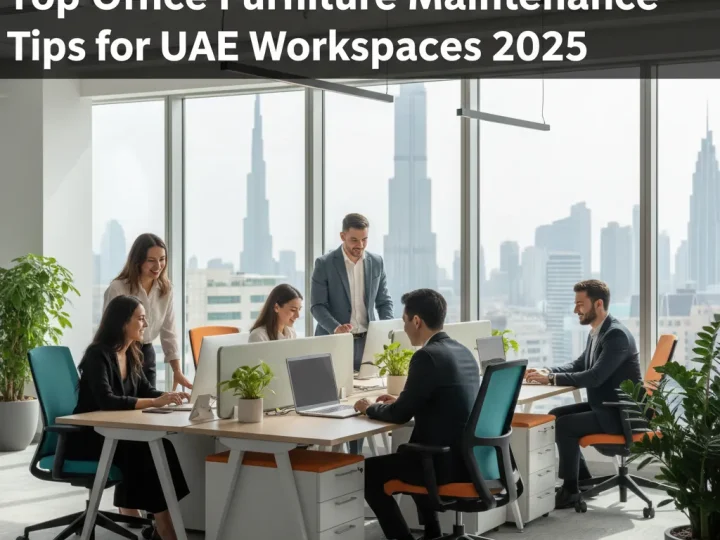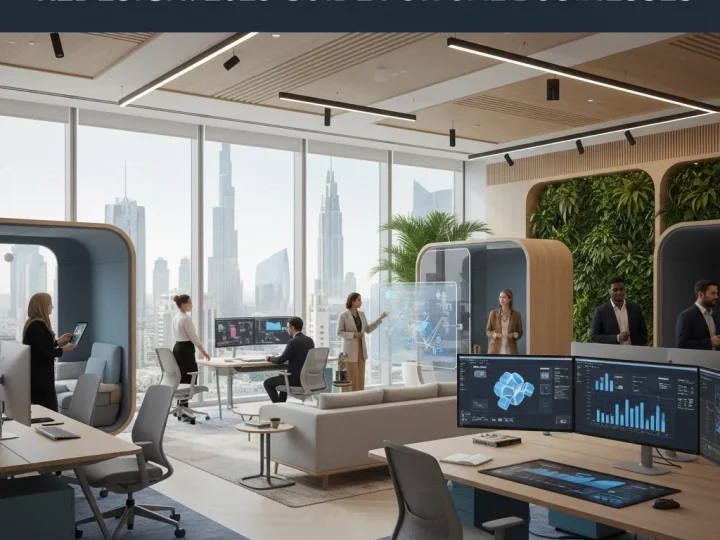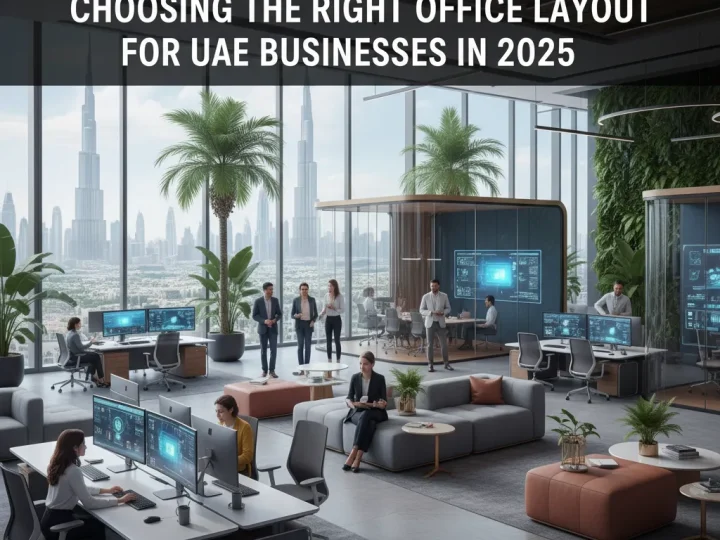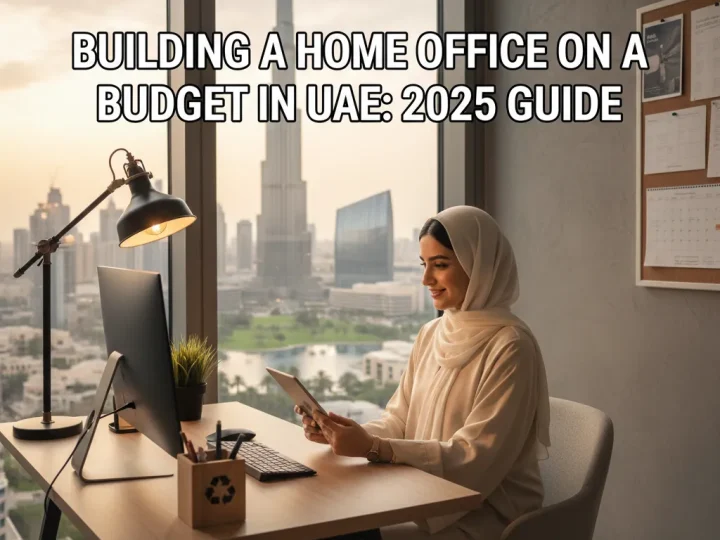

The future of office furniture design is rapidly changing. It’s not just about aesthetics anymore. By 2025, ergonomic furniture is projected to boost productivity by up to 35 percent. But hold on, the real shocker is that comfort is only part of the equation. The real game-changer lies in how office spaces reflect a company’s brand and culture. This transformation opens the door to innovative design strategies that go beyond mere functionality, reshaping the way we view our work environments.
Table of Contents
- Ergonomics And Employee Comfort
- Material Selection And Durability
- Prioritizing Space And Layout
- [Incorporating Brand And Aesthetics](#incorp
 orating-brand-and-aesthetics)
orating-brand-and-aesthetics)
Quick Summary
| Takeaway | Explanation |
|---|---|
| Prioritize Ergonomics | Investing in ergonomic office furniture is essential for enhancing employee comfort and productivity, especially in hybrid work environments. Adjustable desks and supportive chairs are crucial for reducing physical strain and promoting long-term health benefits. |
| Embrace Sustainable Materials | Select eco-friendly materials, such as recycled wood and low-emission finishes, to reflect a commitment to sustainability, which resonates well with modern organizational values and reduces environmental impact. |
| Focus on Flexible Space Design | Utilize strategic zoning and adaptable furniture to create multi-functional work environments that cater to diverse work styles, enhancing collaboration and individual productivity in dynamic settings. |
| Integrate Brand Aesthetics | Design office spaces that communicate organizational identity through visual elements, ensuring aesthetics align with company values to attract and retain top talent in competitive markets. |
| Invest in Durability | Choose high-quality materials that ensure the longevity of office furniture, minimizing replacement costs and supporting a more sustainable lifecycle through initiatives like remanufacturing. |
Ergonomics and Employee Comfort
Designing office furniture that prioritizes employee comfort and health has become a critical strategy for modern businesses, particularly in dynamic markets like the UAE. The relationship between workspace design and workforce productivity is more intricate than ever, with ergonomics emerging as a fundamental consideration for creating supportive work environments.
Understanding Ergonomic Design Principles
Ergonomic office furniture goes beyond aesthetic appeal, focusing on creating workspaces that adapt to human physical needs and capabilities. The key factors in office furniture design now center on reducing physical strain, preventing long-term health issues, and enhancing overall employee well-being.
Modern ergonomic solutions are increasingly sophisticated. Research from No More Pain Ergonomics reveals that AI-driven assessment tools are transforming how businesses approach workplace comfort. These advanced systems use cameras and sensors to provide real-time posture feedback, enabling personalized workstation adjustments that can significantly reduce physical stress.
Adaptive Furniture for Hybrid Work Environments
The rise of hybrid work models has fundamentally changed office furniture design strategies. Companies are now investing in portable, adaptable ergonomic equipment that supports employee comfort across different work settings. According to industry insights, this means developing furniture that can seamlessly transition between office and home environments.
Specifically, this trend includes:
- Foldable standing desks that provide flexibility
- Compact ergonomic chairs with advanced adjustability
- Modular furniture systems that accommodate various work styles
These innovations address the evolving needs of modern professionals, particularly entrepreneurs and startups in dynamic regions like Dubai, where workspace efficiency is paramount.
Health Impact and Productivity Correlation
Ergonomic furniture is not just about comfort—it’s a strategic investment in workforce performance. Adjustable chairs and desks that support individual customization can dramatically improve posture, reduce physical strain, and enhance overall productivity. Gateway Furniture research highlights that proper ergonomic design can lead to significant improvements in employee health and workplace efficiency.
For facility managers and interior designers in the UAE, this means carefully selecting furniture that offers:
- Comprehensive adjustability
- Supportive design features
- Long-term health considerations
By prioritizing ergonomics, businesses demonstrate a commitment to employee well-being that extends far beyond traditional workplace design. In competitive markets like Dubai, such attention to detail can be a significant differentiator in attracting and retaining top talent.
The future of office furniture design is clear: it must be adaptive, intelligent, and fundamentally human-centric. As technology and understanding of workplace dynamics continue to evolve, ergonomic design will remain a critical factor in creating successful, health-oriented work environments.
Material Selection and Durability
In the rapidly evolving landscape of office furniture design, material selection has become a critical consideration that extends far beyond aesthetic preferences. For businesses in the UAE, particularly in innovative markets like Dubai, the choice of materials represents a strategic decision that impacts durability, sustainability, environmental responsibility, and long-term cost-effectiveness.
Sustainable Material Innovation
The contemporary approach to material selection prioritizes sustainability and environmental consciousness. Global Industry Research indicates that businesses are increasingly selecting eco-friendly materials that demonstrate a commitment to reducing environmental impact. This trend encompasses a comprehensive approach to material sourcing and selection.
Key sustainable material innovations include:
- Recycled wood with verified environmental credentials
- Biodegradable fabric compositions
- Low-emission finishing techniques
- Materials that improve indoor air quality
These material choices reflect a broader commitment to creating workspaces that are not just functional, but environmentally responsible. For entrepreneurs and facility managers in the UAE, such selections represent a forward-thinking approach to office design.
Durability as a Strategic Investment
Durability has transitioned from a peripheral consideration to a central strategy in office furniture selection. HOG Furniture Research emphasizes that high-quality materials like solid wood and industrial-grade metals are now preferred for their long-term performance and reduced replacement costs.
The key factors in office furniture design now include:
- Structural integrity that withstands frequent use
- Resistance to wear and environmental conditions
- Potential for modular reconfiguration
- Maintenance and refurbishment potential
For businesses in dynamic markets like Dubai, investing in durable materials means creating workspaces that can adapt to changing organizational needs without requiring complete furniture replacement.
Remanufacturing and Circular Design
A revolutionary shift is occurring in how businesses perceive office furniture lifecycle. Enviro Tech Office Research highlights a growing trend toward reuse and remanufacturing, moving away from the traditional model of constant new purchases.
This approach offers multiple benefits:
- Significant cost savings
- Reduced environmental waste
- Preservation of high-quality furniture assets
- Flexibility for hybrid workspace configurations
Popular items like Aeron task chairs are now being professionally refurbished, extending their functional lifecycle and providing organizations with sustainable, cost-effective solutions.
Material selection in 2025 is not just about immediate performance—it’s about creating intelligent, adaptive workspaces that balance economic, environmental, and functional considerations. For UAE businesses, this means looking beyond traditional procurement strategies and embracing a more holistic, forward-thinking approach to office furniture design.
Prioritizing Space and Layout

In the dynamic business landscape of the UAE, particularly in innovation hubs like Dubai, office space and layout have evolved from mere physical arrangements to strategic tools for enhancing productivity, collaboration, and employee experience. The key factors in office furniture design now extend beyond traditional spatial constraints, focusing on creating adaptive, purposeful work environments.
Strategic Zoning and Workspace Diversification
Office RND Research reveals that modern office design in 2025 is about maximizing every square foot with intentional, multi-functional zones. Companies are moving away from uniform layouts toward diversified work environments that cater to different work styles and organizational needs.
These strategic zones typically include:
- Collaborative open spaces for team interactions
- Quiet, enclosed focus areas for deep work
- Relaxation and informal meeting zones
- Flexible hot-desking regions
For entrepreneurs and facility managers in the UAE, this approach means creating workspaces that are not just efficient, but dynamically responsive to changing business requirements.
Experiential Workplace Design
DLR Group Research emphasizes that modern office layouts are now about creating experiential environments that reflect company culture and support employee well-being. This means furniture arrangements that go beyond functional requirements, telling a story about the organization’s values and work philosophy.
Key considerations in experiential design include:
- Promoting natural collaboration
- Supporting mentorship and knowledge sharing
- Creating spaces that inspire creativity
- Reflecting organizational identity through spatial design
In competitive markets like Dubai, such thoughtful design can be a significant differentiator in attracting and retaining top talent.
Flexibility and Adaptive Furniture Solutions
Artopex Furniture Insights highlight the critical role of height-adjustable and versatile furniture in modern office layouts. The future of workspace design is fundamentally about adaptability—creating environments that can seamlessly transform to meet diverse employee needs.
This adaptability manifests through:
- Height-adjustable desks that accommodate different working postures
- Modular furniture systems
- Easily reconfigurable workspace elements
- Technology-integrated furniture solutions
For UAE businesses, investing in such flexible furniture means creating resilient workspaces that can quickly adapt to hybrid work models, technological changes, and evolving organizational structures.
Prioritizing space and layout is no longer just about arranging furniture—it’s about creating intelligent, responsive environments that enhance productivity, support employee well-being, and reflect the dynamic nature of modern businesses. In the competitive landscape of the UAE, a well-designed office is a strategic asset that can significantly impact organizational success.
Incorporating Brand and Aesthetics
In the competitive business landscape of the UAE, office furniture has transcended its traditional functional role to become a powerful medium of brand communication and organizational identity. The key factors in office furniture design now integrate aesthetic expression with strategic messaging, transforming workspaces into visual narratives that reflect a company’s culture, values, and professional ethos.
Visual Identity and Brand Storytelling
Facility Management Global Insights reveals that contemporary office design is a sophisticated language of brand communication. Companies are strategically using furniture and design elements to communicate their unique organizational personality, creating environments that serve as three-dimensional representations of their core values.
For instance:
- Tech startups might employ sleek, minimalist furniture to represent innovation
- Eco-conscious organizations select sustainable materials demonstrating environmental commitment
- Creative industries utilize vibrant, unconventional design elements
- Professional service firms might choose sophisticated, refined furniture configurations
In dynamic markets like Dubai, this approach transforms office spaces from mere work environments into powerful brand ambassadors that speak volumes about organizational identity.
Strategic Aesthetics and Talent Attraction
Decorilla Design Research emphasizes that office aesthetics have become crucial in talent acquisition and retention strategies. Modern professionals, particularly in the UAE’s competitive job market, view workspace design as a significant factor in employment decisions.
Aesthetic considerations now include:
- Alignment with organizational culture
- Creating inspirational work environments
- Reflecting company’s forward-thinking approach
- Demonstrating investment in employee experience
For entrepreneurs and facility managers, this means carefully curating spaces that not only look impressive but also communicate the organization’s commitment to employee well-being and professional growth.
Functional Aesthetics and Design Philosophy
Beyond visual appeal, contemporary office design integrates aesthetics with functionality. The most successful workspace designs create harmonious environments where beauty and practicality coexist seamlessly. This holistic approach ensures that aesthetic choices support, rather than compromise, workplace efficiency.
Key principles of functional aesthetics include:
- Ergonomic design that looks elegant
- Color palettes that enhance psychological comfort
- Materials that combine durability with visual appeal
- Furniture configurations that facilitate collaboration
In the UAE’s competitive business landscape, particularly in innovation hubs like Dubai, these nuanced design approaches differentiate organizations, making workspace aesthetics a critical component of overall brand strategy.
Incorporating brand and aesthetics into office furniture design is no longer a luxury—it’s a strategic imperative. By thoughtfully integrating visual identity, functional design, and organizational values, businesses can create workspaces that inspire, communicate, and elevate their professional narrative.
Frequently Asked Questions
What are the key factors in office furniture design for 2025?
The key factors in office furniture design for 2025 include prioritizing ergonomics for employee comfort, selecting sustainable materials, focusing on flexible space design, and integrating brand aesthetics to reflect organizational culture.
How does ergonomic furniture affect productivity?
Ergonomic furniture is projected to boost productivity by up to 35 percent by reducing physical strain, enhancing employee comfort, and promoting long-term health benefits, especially in hybrid work environments.
Why is sustainable material selection important in office furniture design?
Sustainable material selection is crucial as it demonstrates a company’s commitment to environmental responsibility, resonates with modern organizational values, and helps reduce overall environmental impact.
What is the role of flexibility in modern office furniture?
Flexibility in modern office furniture is essential for creating adaptable workspaces that cater to diverse work styles, promoting collaboration, and allowing for seamless transition between different work settings.
Transform Your Workspace for 2025 with SAGTCO
As highlighted in the recent article on office furniture design for 2025, prioritizing ergonomics and flexibility is crucial for enhancing productivity and employee well-being. The shift towards hybrid work environments demands furniture solutions that not only look great but also support the diverse needs of today’s workforce. Imagine a workspace that combines stunning aesthetics with innovative design—one that reflects your brand and boosts productivity by up to 35%. Sounds ideal, right?

At SAGTCO, we specialize in crafting modern, customizable office furniture that meets the unique demands of the UAE market. With a comprehensive catalog and expert consultation for free space planning, we can help you bring your vision to life. Let us assist you in selecting sustainable materials and flexible designs that enhance every corner of your workspace. Why wait? Elevate your office environment today—visit us at https://sagtco.com and discover how to transform your workplace into a hub of productivity and innovation!

 orating-brand-and-aesthetics)
orating-brand-and-aesthetics)



